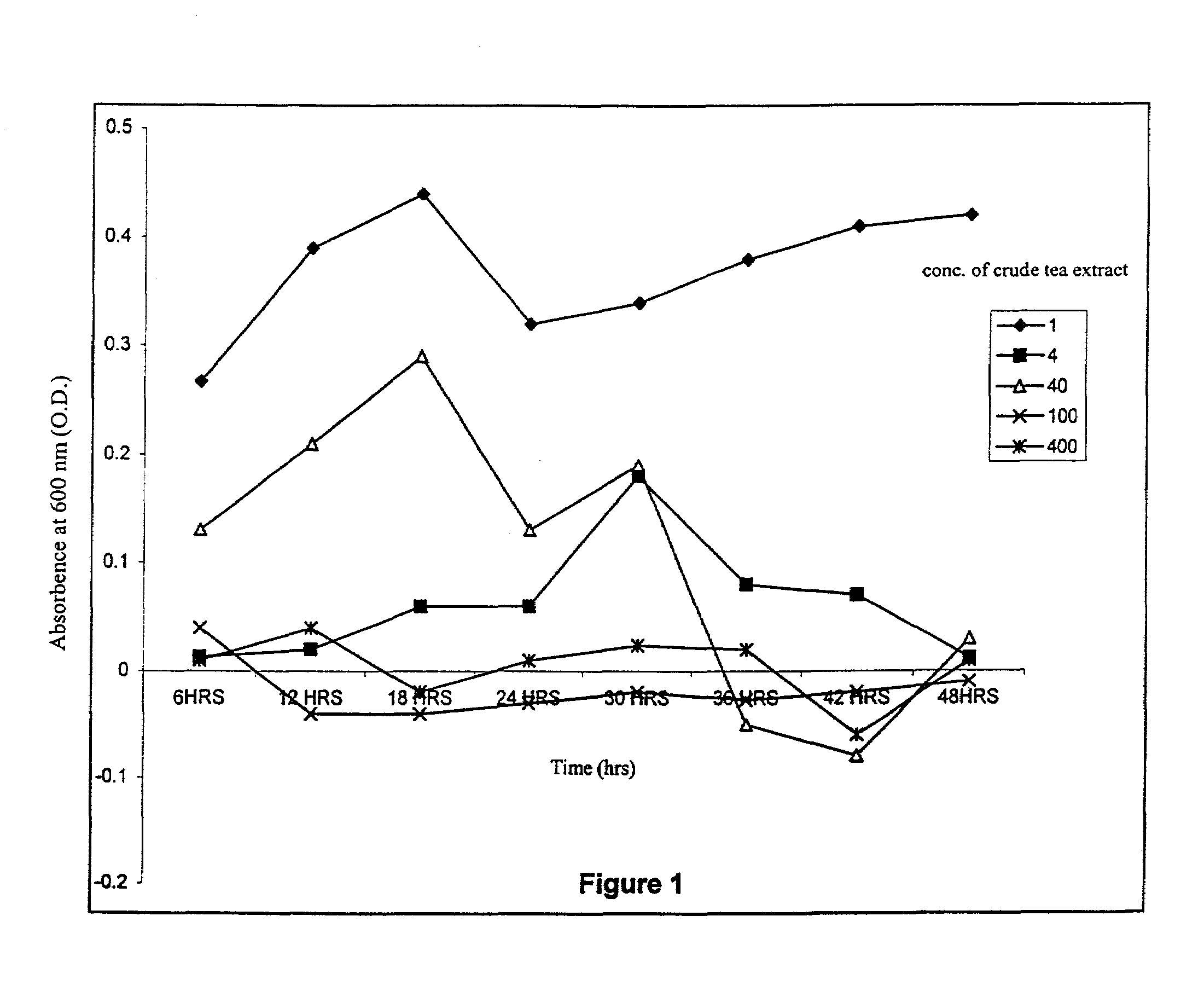Efficient method of preventing growth of microbial genetic transformant after transformation
a technology of genetic transformation and efficient method, which is applied in the direction of biocide, plant/algae/fungi/lichens ingredients, biochemistry apparatus and processes, etc., can solve the problems of agrobacterium tumefaciens mediated genetic transformation protocols, high cost and labor intensive steps of washing and subsequent repeated culturing, and 50% of the transformants are los
- Summary
- Abstract
- Description
- Claims
- Application Information
AI Technical Summary
Benefits of technology
Problems solved by technology
Method used
Image
Examples
example-1
[0115]Two strains of Agrobacterium tumefaciens viz. EHA105 (mild) and GV2260 (virulent) harbouring the antibiotic resistance genes for kanamycin or hygromycin and the reporter gus gene were inoculated from mother cultures of respective strains into 10–30 ml liquid modified Yeast Mannitol Broth with kanamycin or hygromycin. The cultures were incubated for 12–16 hr at 25–30° C. and 150–200 rpm in dark and harvested at 0.6–0.8 optical density at 600 nm for 1×109 cells / ml during log phase of bacterial growth. The living bacterial cells were pelleted by centrifugation at 15–30 minutes at 4000–8000 rpm and 25–30° C. and suspended in fresh 5–25 ml of Yeast Mannitol Broth without damaging the bacterial cells. The bacterial cell density at 1×109 cells / ml was optimized by measuring optical density at 600 nm.
[0116]Various explants of different plants were immersed in bacterial suspension for 5–35 minutes and blotted on filter papers to remove excess Agrobacterium tumefaciens. The explants were...
example-2
[0119]Two strains of Agrobacterium tumefaciens viz. EHA105 (mild) and GV2260 (virulent) harbouring the antibiotic resistance genes for kanamycin or hygromycin and the reporter gus gene were inoculated from mother cultures of respective strains into 10–30 ml liquid modified Yeast Mannitol Broth with kanamycin or hygromycin. The cultures were incubated for 12–16 hr at 25–30° C. and 150–200 rpm in dark and harvested at 0.6–0.8 optical density at 600 nm for 1×109 cells / ml during log phase of bacterial growth. The living bacterial cells were pelleted by centrifugation at 15–30 minutes at 4000–8000 rpm and 25–30° C. and suspended in fresh 5–25 ml of Yeast Mannitol Broth without damaging the bacterial cells. Measurement of optical density at 600 nm at regular 6 hr intervals for 0–48 hr and the mean of three readings were plotted for development of the growth curve.
[0120]Crude mixture of catechins as well as caffeine at concentrations of 2–600 μg / ml were added to fresh cultures of Agrobacte...
example-3
[0121]Single colony of Agrobacterium tumefaciens was streaked on agar solidified plates containing different concentrations 2–600 μg / ml of crude tea leaf extract containing mixture of catechins and caffeine in order to determine its bactericidal effect on agar solidified media by incubating the plates at 25–30° C. in dark for 12–16 hr.
Advantages of the Present Invention
[0122]1. The main advantage of the present invention is that its an efficient and cost effective method of preventing growth of genetic transformant bacteria Agrobacterium tumefaciens after transformation in plants by using tea leaf extract as a bactericide.
[0123]2. Another advantage of the instant application is that it's a method for enhanced genetic transformation in plant systems using bacteria Agrobacterium tumefaciens as the transformant.
[0124]3. Yet another advantage of the present invention is that it's a method for prevention of overgrowth of genetic transformant of plants wherein the growth of the plant afte...
PUM
| Property | Measurement | Unit |
|---|---|---|
| concentration | aaaaa | aaaaa |
| temperature | aaaaa | aaaaa |
| optical density | aaaaa | aaaaa |
Abstract
Description
Claims
Application Information
 Login to View More
Login to View More - R&D
- Intellectual Property
- Life Sciences
- Materials
- Tech Scout
- Unparalleled Data Quality
- Higher Quality Content
- 60% Fewer Hallucinations
Browse by: Latest US Patents, China's latest patents, Technical Efficacy Thesaurus, Application Domain, Technology Topic, Popular Technical Reports.
© 2025 PatSnap. All rights reserved.Legal|Privacy policy|Modern Slavery Act Transparency Statement|Sitemap|About US| Contact US: help@patsnap.com

